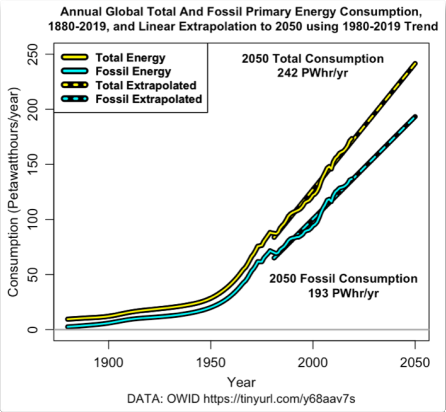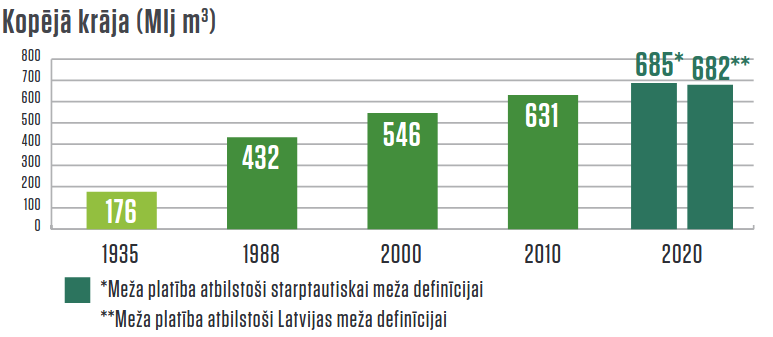The road to a climate-neutral future
Several countries around the world, such as UK, France, Denmark, New Zealand, Hungary, Japan and South Korea, are committed to achieve climate neutrality by 2050. In following article it is calculated, how much is needed to get rid of fossil fuels worldwide and no longer emit CO2 by 2050.
How much energy will be needed
Most people have little idea how much energy we get from fossil fuels. As Vaclav Smil pointed out, we are still practically a fossil fuel civilization. The following figure shows the total annual consumption of energy and fossil fuel from 1880 to 2019 with extension of this trend till 2050. Estimates of future trends in total energy consumption for 2050 are in line with the World Energy Council's (EIA) 2050 estimates of 900 × 1015BTU or 300PWh per year.
Primary energy consumption 1880-2019 and modest extrapolation to 2050
In order to achieve zero emissions by 2050, we will have to replace around 193PWh or 1015Wh of fossil fuel energy per year. As there are 8766 hours per year, 193PWh/8766 hours per year ≈ 22TW or 1012W energy production source. (The site Unit Juggler has been used for all unit conversions.)
From 2021 to 2050, there are about 10,000 days. So we have to install and connect to the grid about 22TW/10000 days = 2GW or 109 watts of green energy sources every day from today till 2050. We can do this in different ways:
- We can only use nuclear energy. Thus, by 2050, we will have to build one 2GW nuclear power plant every day.
- Some believe that fossil fuels can be used if the CO2 they generate is captured and stored with Carbon Capture and Storage — CCS technology. To date, the world's largest carbon capture station is able to collect 4000t of carbon dioxide. To collect and store all the CO2 produced by fossil fuels 10 million of such plants have to be built, or 1000 such plants every day.
- Don't like nuclear power? Then we can use wind energy. The wind doesn't blow all the time. Tip "power factor" or the percentage of actual energy produced by the wind, the maximum installed capacity is 35%. Thus by 2050 we each day will have to build 3,000 150m high 2MW or 106W wind turbines.
- Don't like the wind? Then we can use solar panels. The power factor of the solar panel is very different from place to place — from 8% in cloudy places closer to the poles to 30% close to the equator and clear skies. The US NREL has an estimated solar power of 8.3W per day, therefore till 2050 we to place solar panels on 250km2 or 4 × more than world's largest 10GW planned solar panel station in Australia every day.
- Most people are not aware of how much space is needed for diluted energy sources. In order to get everything you need only from the sun and wind, wind turbines and solar panels must cover a significant part of the Earth. The sun is periodic, but the wind is a unpredictable source of energy. That is why we still will need around 50%..90% of all energy sources to be produced by nuclear energy when the sun is not shining and wind is not blowing.
We can store energy for windless nights in chemical batteries. A good battery can store around 150Wh/kg. Today, all batteries produced in the world can store few seconds of energy of entire world. In order to accumulate reserve of energy for only one day in 2050, 193PWh/365 days/150Wh/kg = 3.5Pg or 3.5Gt of chemical batteries will be needed. And to reach that goal in 10,000 days, we will have to produce, connect and charge 350Gg or 350,000t of batteries every day.
What to do worldwide
In order for the world to achieve zero CO2 emissions by 2050, we have to do following every day:
- build and connect two 2GW nuclear power plants, or
- build 1000 carbon capture and storage stations, or
- install 3000 2MW wind turbines in the area of 3000 ha, equip them with distribution and transmission networks, and build and connect one 3GW nuclear power plant to the network, or
- build a 40 GW solar panel station in an area of 250km2, equip it with distribution and transmission networks, and build and connect one 3GW nuclear power plant to the network, or
- without the use of nuclear energy, install and charge 350000t of chemical batteries for one day's energy reserve.
- starting from 2040 also replace most of the older wind turbines, solar panels and chemical batteries.
What to do in Latvia
In Latvia, energy consumption is not growing much and in recent years it is around 200PJ or 60TWh per year, what on average is 7GW of power all the time. Latvia's CO2 emissions in 2020 were 10.4 Mt. In order to neutralize this amount by capturing carbon dioxide, it is necessary to build 2,600 of the world's largest collection stations, or one such station in less than 4 days.
Latvia is one of the most forested countries in Europe. Therefore energy needs could be covered by local biomass. According to the forest sector 2022 annual report About 5 mln.m3 of wood grows annually in Latvia (10 in the years from 630 to 680 milln.m3). Evaluating the average density of wood 600 kg/m3 and the energy content of wood 20MJ/kg, it is 5×106m3×600kg/m3×20×106J/kg = 6×1016J or 60PJ per year. So, by burning all the wood grown in Latvia in a year, it can provide only a third of the annual energy consumption.
In order for Latvia to achieve zero CO2 emissions by 2050, we need:
- build one 2GW nuclear power plant every 10 years or smaller ones more often, or
- build one carbon dioxide capture station every 4 days, or
- burn all newly grown wood biomass in Latvia and import 2x more, or
- find a 10ha site to install 10 2MW wind turbines every month, or
- find 2km2 place covered with solar panels every month, and
- install and charge 3000t batteries every month to store energy for one day.
- starting from 2040 also replace most of the older wind turbines, solar panels and chemical batteries.
Of course, these energy sources can be combined, respectively providing only a part of the total consumption. And needs can be as much/slightly smaller as energy efficiency is improved.
I allow everyone to evaluate by themselves, which of these plans is most possible to implement.
This is still a modest needs assessment, as the calculated quantity is average capacity. The energy system must provide maximum rather than average demand capacity. (If not, there is not enough energy at all during peak demand, as is electricity in California and Texas.) Depending on location and needs, peak power can be 1.6 to 2.3 times higher than average power.
The above figures also exclude energy needed to obtain, recycle and transport necessary materials, as well as the energy needed to build the energy sources themselves. The energy required to build nuclear reactors is low, but in the case of wind and solar energy it is considerable energy sources require huge areas and long transmission lines. These figures also do not take into account the fact that the lifespan of nuclear power plants is at least 50 years and none of them will have to be refurbished in 30 years, but wind turbines and solar panels have a lifespan of around 20..25 years, so we will not only have to install new wind turbines and solar panels, but also will have to dismantle and recycle/dispose millions of wind turbines and hundreds thousands of square kilometres of solar panels. Ageing of batteries and the energy required to recycle old batteries is also not included in the calculations.
The figures also do not include the fact that, in the transition to a fully electric economy, we will have to completely transform, expand and improve the existing electricity grid, including all related equipment: transformers, power lines, switches and distributors. It will take a huge investment of time, money and energy. Energy-intensive plants such as steel and cement will also have to be converted. Homes will also have to be redesigned, as all homes that heat gas and use gas for water heating and cooking will have to significantly increase the amount of electricity they supply and install electric heating, stove and water heater.
The idea of the article is borrowed from Bright Green Impossibilities and supplemented with other sources, including about Latvia.
Created by Valdis Vītoliņš on 2021-11-17 13:15
Last modified by Valdis Vītoliņš on 2023-10-03 14:45






